EUGreenWeek 2021 event: “Greening Energy in Rural Areas through the Valorization of Agricultural Residues”
On 11 June, Bioenergy Europe and Horizon 2020 AgroBioHeat consortium, co-hosted a #EUGreenWeek 2021 partner event dedicated to the valorisation of agricultural residues.
During the webinar, sector and policy experts shared their views on the potential and challenges related to the use of agricultural residues for energy production. Focusing on the environmental and socio-economic benefits of agrobiomass, the event assessed the way forward to capitalise on the untapped potential for rural communities and Europe as a whole. In particular raising awareness on agricultural practices, benefits of agrobiomass valorisation, increased cooperation among farmers and most importantly, access to funding.
Manolis Karampinis, Research Associate at Centre for Research and Technology Hellas (CERTH) and Coordinator of AgroBioHeat project, opened the event giving an overview on the current state of the agrobiomass sector: despite little awareness on its potential, several studies and practical examples across Europe demonstrate clear benefits of maximising the use of locally available biomass from agricultural practices.
In his keynote speech, Olaf Nährig, Senior Area Manager at Amandus Kahl, highlighted that the use of agrobiomass adds value in rural areas by increasing income for farmers and boosting the economic efficiency of the local infrastructure. He also pointed out that readily available advanced technologies play an important role in reducing emissions when utilizing agricultural residues.
Kicking off the panel discussion on the obstacles in the optimal use of agricultural residues, Jérôme Maillet, Export Area Manager at COMPTE.R, stated that when producing the equipment, a standardization of material is needed to assure homogenous quality. Another challenge is that every type of residue is different and specific needs (e.g. gross and net value, physical shape, chemical composition of the residues…) must be considered.
As a producer of briquettes from straw, Sales Director Barbara Pokrzywa from Asket highlighted current misconceptions on straw efficiency, open field burning practices and financial burdens for famers when adopting biomass technologies. Awareness raising among local communities and stronger cooperation between farmers and along the value-chain are still needed to promote straw-to-energy practices. Agrobiomass can become a driver for rural socio-economic development, contributing to energy safety and independence, and fighting energy poverty being aligned with the EU Green Deal’s objectives.
Michael Wolf, Research Programme Officer at DG AGRI (European Commission), confirmed that there are untapped biomass sources available from abandoned or not fit for food production land. Therefore, it is paramount to develop value-chains in which primary producers are fully and effectively integrated.
This will require new forms of cooperation and create skillful jobs where innovative know-how is needed. Achieving an integrated value-chain is only possible by enabling farmers to bring in their practical knowledge and skills in a supporting environment and involving them in business models that can be adapted to their own specific needs.
Tajana Radić, Head of Agricultural Policy, Croatian Chamber of Agriculture reiterated the need to raise awareness on agrobiomass potential and couple it with investments aimed at promoting the valorisation and mobilisation of agricultural residues. Despite successful agrobiomass business models in the context of EU-funded projects, Radić regrets the lack of financial and organizational support schemes to putting these models into practice. Cooperatives and producer associations are a viable solution to help farmers re-organize themselves. Dedicated financial schemes can boost jobs creation, guarantee energy security in rural areas, promote local bioeconomies, while reducing the possibility of land abandonment.
Daniel Garcia, Responsible for promotion and Innovation at the Spanish Biomass Association (AVEBIOM), stressed that agrobiomass is more complex to use than woody-based products and consequently the price of handling mobilisation can be higher and represents an obstacle for farmers. In addition, unused biomass sources need to be supported by policies and incentives to facilitate the possibility to mobilise them and to increase the demand. Garcia also pointed out, that there is a limited understanding that bioenergy is totally compatible with carbon capture and sustainable soil management. A public debate is needed so that policy makers can make informed decisions that are most beneficial for society and the ecosystem.

